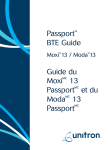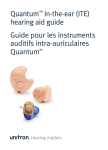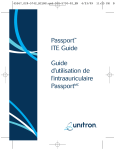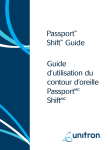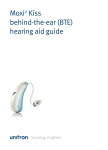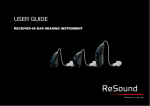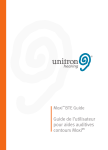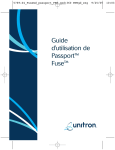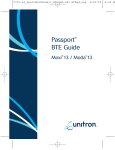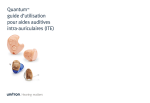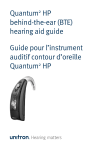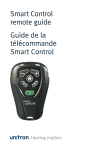Download 360 BTEgd_eng,x-default
Transcript
Passport™ BTE guide Moxi™ 3G Guide d'utilisation PassportMC MoxiMC 3G Table of contents Your Passport™ hearing instruments.............................1 Table des matières Vos instruments auditifs PassportMC ............................25 Overview of your hearing instrument.............................2 Aperçu de votre instrument auditif ..............................26 Features of your hearing instrument ..............................4 Caractéristiques de votre instrument auditif ...............28 Putting your hearing instruments on your ears..............5 Mise en place de vos instruments auditifs sur vos oreilles .................................................................29 Turning your hearing instruments on and off ................6 Battery information.........................................................7 Operating instructions....................................................9 Caring for your hearing instruments .............................14 Cleaning your hearing instruments...............................15 Mise en marche et arrêt de vos instruments auditifs ..................................................30 Informations sur la pile .................................................31 Instructions d'utilisation...............................................33 Entretien de vos instruments auditifs ..........................38 Signature features of your Passport™ hearing instruments ................................................................16 Nettoyage de vos instruments auditifs ........................40 Assistive listening devices ............................................17 Fonctions distinctives de vos instruments auditifs PassportMC ...................................................................41 Warnings .......................................................................18 Troubleshooting guide..................................................22 Notices..........................................................................49 Aides de suppléance à l'audition .................................42 Avertissements .............................................................43 Guide de dépannage ....................................................47 Your Passport™ hearing instruments Hearing healthcare professional: _______________________ ___________________________________________________ Telephone: _________________________________________ Model:_____________________________________________ Serial number: ______________________________________ Replacement batteries: size 312 Warranty: __________________________________________ Program 1 is the automatic program Program 2 is the manual program for: ___________________ Program 3 is the manual program for: ___________________ Program 4 is the manual program for: ___________________ Date of purchase: ____________________________________ 1 Overview of your hearing instrument The diagrams identify some of the components on your hearing instruments. Have your hearing healthcare professional place a check beside the diagram that best describes your hearing instrument style and attachment. Attachment style (check one) 4 1 2 5 3 7 My hearing instrument has (check all that apply) SmartFocus™ (with optional Smart Control) Volume control Program button DuoLink Binaural Phone Optional accessories (check all that apply) Smart Control uDirect™ 6 Moxi 3G with dome 1 4 Legend 1 Microphone 2 Program button or volume control (depending on your customized fitting) 3 Battery door/ on & off switch 4 Tube 5 Dome 6 Retention piece 7 Speaker unit 8 Shell 2 3 See user guides for more information. 7 8 Moxi 3G with shell 2 3 Features of your hearing instrument Passport premium hearing instruments come equipped with the following features: • Automatic listening program • 3 additional manual programs • SmartFocus with personal adjustments for clarity and comfort settings (available with the optional Smart Control) • Wireless capability with DuoLink and Binaural Phone • Optional wireless connectivity to other devices It may take some time for you to fully adjust to your new hearing instruments. In the beginning, do not feel as though you need to wear them for longer than is comfortable. Depending on your previous experience with hearing instruments you can increase wearing time gradually until you have fully adjusted to them. Eventually, you should wear your Passport hearing instruments all day every day. Please consult your hearing healthcare professional regarding any adjustments you may require to ensure that you are happy with your hearing instrument. For instance, pitch and loudness of the beeps can be adjusted or turned off entirely. Also note that this is a general guide and your hearing healthcare professional may have enabled or disengaged certain features depending on your requirements. 4 Putting your hearing instruments on your ears Your hearing instruments may be color-coded red for your right ear and blue for your left ear. This color indicator is located inside the battery door with a small colored dot. Hearing instruments with domes 1. Hold the tube where it attaches to the dome and gently push the dome into your ear canal. The tube should lie flush against your head and not stick out. 2. Place the hearing instrument over the top of your ear. 3. Place the retention piece in your ear so it rests at the bottom of the opening of your ear canal. Hearing instruments with shells 1. Carefully insert the shell into your ear. The shell should fit into your ear snugly and comfortably. The tube should lie flush against your head and not stick out. 2. Place the hearing instrument over the top of your ear. 5 Turning your hearing instruments on and off Battery information Your hearing instruments have a three-position battery door that acts as an on/off switch and that allows access to the battery compartment. ON: To turn the hearing instruments on, close the battery door fully. Note: It may take 5 seconds before the hearing device turns on. Your hearing healthcare provider can additionally increase the start up delay if required. OFF: To turn the hearing instrument off, partially open the battery door. This position also allows excess moisture to vent away from the battery compartment. on off open Note: When turning your hearing instrument on and off while it is on the ear, grasp the top and bottom of the instrument with your index finger and thumb. Use the index finger of your opposite hand to open and close the battery door. 6 To replace the hearing instrument battery, fully open the battery door for access to the battery compartment. Low battery warning Two long beeps indicate the hearing device battery is low. After the low battery warning, you may experience some reduction in sound quality. This is normal and can be remedied by inserting fresh batteries into the hearing devices. If you are not able to hear the low battery warning, your hearing healthcare professional can change the pitch or loudness of the low battery warning. If you prefer, it can be turned off entirely. Your hearing devices are designed to generate a low battery warning every 30 minutes until you change the batteries, but depending on the condition of the batteries, the batteries may die before another low battery warning occurs. Therefore, it is recommended that the batteries are replaced as soon as possible once you hear the low battery warning. Replacing the battery 1. Gently swing out the battery door with your fingernail, or grasp the top and bottom of the instrument with your index finger and thumb. You 7 can use your index finger to open and close the battery door if this is easier. 2. Grasp the battery with your thumb and index finger and remove. 3. Insert the new battery into the battery compartment matching it with the battery symbol inside the battery door. This will ensure that the battery door closes properly. 4. Close the battery door. Note: If the battery is inserted incorrectly, the hearing instrument will not turn on. Caring for batteries • Always discard batteries in a safe and environmentally friendly way. • To prolong battery life, remember to turn your hearing devices off when not in use. • Remove the batteries and keep the battery door open while hearing devices are not in use. This will allow internal moisture to evaporate. Operating instructions Push button Your hearing instrument is equipped with a push button, which has been set for switching between programs or adjusting your volume. Program control If you have an active push button program control, each time you push the button, you will move to a new program. Also if DuoLink is enabled, the hearing instrument is set so that by pressing the push button on one hearing instrument, both hearing instruments will change programs. Your hearing instruments beep to indicate which program you are in (i.e. one beep for program 1, two beeps for program 2, etc.). Program 1 (e.g. automatic program) 1 beep Program 2 (e.g. group/party noise) 2 beeps Program 3 (e.g. easy-t/telephone) 3 beeps Program 4 (e.g. music) Easy-t/telephone DuoLink (if enabled) 4 beeps short melody opposite ear beeps the same as side being adjusted Your Passport hearing instruments may also come with an optional remote control which allows you to switch 8 9 between different listening programs. Please refer to your Smart Control user guide for more information. Volume control If your push button has been configured as a volume control, you can adjust the volume level by pushing the button. If DuoLink is enabled, the hearing instrument can also be set so that by changing the volume on one hearing instrument, both will be adjusted. Your Passport hearing instruments will learn your volume control adjustments while the hearing instruments are set to the automatic program, if this feature has been enabled by your hearing healthcare professional. Over time, the hearing instruments will adjust the default volume settings in the automatic program to the levels that you typically use. Your hearing healthcare professional can help you identify your different push button volume control settings. Volume setting SmartFocus can be accessed through the optional Smart Control. For improving clarity of sounds in front of you, such as speech, the scroll wheel on the Smart Control can be turned upwards. For greater overall listening comfort in noisy situations, turn the scroll wheel on the Smart Control downwards. Each step will change the hearing instrument performance. Sometimes multiple steps are required to achieve the desired listening results. After each step wait for about 4-5 seconds to allow the hearing instrument to adjust to the new setting. Beeps Ideal volume level 1 beep Increased loudness 1 beep + 1 high-pitched beep Decreased loudness 1 beep + 1 low-pitched beep 10 SmartFocus™ (available on optional Smart Control) 11 Using the telephone As telephones do not all work the same, you may experience different results from different phones. You can use many phones by simply holding the receiver to your ear, without the need to change to a dedicated telephone program. Remember to move the handset slightly up or back to find the position that sounds best to you. Depending on the phone type you use, your hearing healthcare professional might have selected a dedicated phone program on your hearing instruments. Therefore your hearing instrument may have an automatic telephone program (easy-t feature), which automatically switches you to a dedicated telephone program when your hearing instrument is close to a telephone receiver. When the receiver is moved away from the hearing instrument it will automatically return to the previous listening program. If the hearing instrument does not switch to the telephone program automatically when the telephone receiver is placed in proximity, the magnet for easy-t hearing instruments should be attached to the telephone receiver. The magnet is designed to strengthen the magnetic field at the ear piece of hearing instrument compatible telephones. If your Passport hearing instruments are configured to work with the wireless uDirect accessory, you might 12 benefit from a Bluetooth hands free option. Refer to the uDirect user guide for more information. If DuoLink is enabled for the automatic phone program, both hearing instruments are synchronized and the listening preference for the opposite ear will also change when an automatic phone program is activated. Consult your hearing healthcare professional if you experience difficulties using your hearing instruments on the phone. To affix the optional easy-t magnet: 1. Clean the telephone receiver. 2. Hold the magnet near the “listening end” of your telephone receiver and release it (figure 1). The magnet will flip to the appropriate side and seek the optimal position on the telephone receiver. 3. Place the double-sided tape in this optimal position on the telephone receiver (figure 2) and attach the magnet to the tape (figure 3). Figure 1 Figure 2 Figure 3 13 Caring for your hearing instruments Cleaning your hearing instruments • Open the battery door when not in use. • Always remove your hearing instruments when using hair care products. The hearing instruments can become clogged and cease to function properly. • Do not wear your hearing devices in the bath or shower or immerse them in water. • If your hearing instruments do become wet, do not attempt to dry them in an oven or microwave. Do not adjust any controls. Open the battery doors immediately, and allow your hearing instruments to dry naturally for 24 hours. • Protect your hearing devices from excessive heat (hair dryer, vehicle glove box or dashboard). • Ensure you do not twist or squeeze the tube when your hearing instruments are placed in their case. • Regular use of a dehumidifier, such as a Dri-Aid kit, can help prevent corrosion and prolong the life of your hearing instruments. • Do not drop your hearing devices or knock them against hard surfaces. Ear wax is natural and common. Ensuring your hearing devices, shells and domes are free of ear wax is an important step in your daily cleaning and maintenance routine. • Never use alcohol to clean your hearing devices, shells or domes. • Do not use sharp tools to dislodge ear wax. Sticking household items into your hearing devices or shells can seriously damage them. 14 Cleaning the shells and domes 1. Clean the domes and shells on the outside daily with a damp cloth. Avoid getting any water in and around the speaker units and shells. Note: The tubes, speakers, domes or shells should never be rinsed or submerged in water as water drops may block sound or damage the electrical components of the hearing instrument. 2. Domes should be replaced by your hearing healthcare provider every 3-6 months. 3. If your shells require further cleaning, the speaker waxguard may be plugged and require replacing. See your hearing healthcare professional. 15 Signature features of your Passport™ hearing instruments SmartFocus™ With a Passport hearing instrument, you can adjust the focus on hearing speech or background noise in your listening environment via the SmartFocus on your optional Smart Control. This control provides an additional fine tuning adjustment beyond a traditional volume control. You can adjust your SmartFocus control to focus on speech (clarity) or soften background noise (comfort) using the dial on your Smart Control. As you adjust smartFocus, your Passport hearing instruments will learn your SmartFocus clarity and comfort settings while the hearing instruments are set to the automatic program. Over time, the hearing instruments will adjust the pre-programmed SmartFocus settings to your preferred levels. The optional Smart Control hand-held remote control allows you to adjust your SmartFocus clarity and comfort levels. DuoLink With DuoLink, your hearing instruments wirelessly communicate with each other. As you make a program or volume change on one hearing instrument, the other hearing instrument automatically changes as well. An additional benefit occurs while using the phone since as one hearing instrument detects the phone, the other 16 hearing instrument can be programmed to mute sound to eliminate distractions. Binaural Phone With the Binaural Phone feature, landline and mobile phone calls can be heard clearly and automatically in both ears without any additional accessories. uDirect™ Your Passport hearing devices may come with an optional uDirect, a device that is worn around your neck, and provides secure connectivity between your hearing instruments and Bluetooth-enabled devices (i.e. cell phones), wired audio input jacks, or FM transmitted signals. uDirect provides easy hands-free access to clear stereo, or audio signals automatically activated when a signal is detected. Assistive listening devices Listening in public places Passport’s telecoil option can also help you listen in public places equipped with telecoil compatible assistive listening devices such as a loop system. When you see this symbol, it means that there is loop system installed; this loop system is compatible with your hearing instrument. Please contact your hearing healthcare provider for more information on loop systems. 17 Warnings Hearing devices should only be used as directed by your physician or hearing healthcare professional. Hearing devices will not restore normal hearing and will not prevent or improve a hearing impairment resulting from organic conditions. Do not use your hearing devices in explosion hazard areas. Allergic reactions to hearing devices are unlikely. However, if you experience itching, redness, soreness, inflammation or a burning sensation in or around your ears, inform your hearing healthcare professional and contact your physician. In the unlikely case that any parts remain in the ear canal after the removal of the hearing instrument, contact a physician immediately. Remove your hearing devices for CT and MRI scans or for other electromagnetic procedures. Special care should be exercised in wearing hearing devices when maximum sound pressure levels exceed 132 decibels. There may be a risk of impairing your remaining hearing. Speak with your hearing healthcare professional to ensure the maximum output of your hearing devices is suitable for your particular hearing loss. 18 Magnet warnings Be sure the magnet is securely affixed to the telephone. Keep loose magnets out of reach of children and pets. If the magnet falls into your ear, contact your hearing healthcare professional. If the magnet is swallowed, contact your physician immediately. The magnet may affect some medical devices or electronic systems. Always keep the magnet (or the telephone equipped with the magnet) at least 30 cm (12”) away from pacemakers, credit cards, floppy disks or other magnetically sensitive devices. Too high distortion during dialing or phoning may mean that the phone handset is stressed by the magnet. To avoid any damage, please move the magnet to another place on the telephone receiver. Battery warnings Never leave hearing devices or batteries where small children and pets can reach them. Never put hearing devices or batteries in your mouth. If a hearing device or battery is swallowed, call a physician immediately. 19 Warning to hearing healthcare professional: Domes should never be fitted on patients with perforated eardrums, exposed middle ear cavities, or surgically altered ear canals. In the case of such a condition, we recommend to use a customized ear mold. Labeling The serial number and year of manufacture are located inside the battery door. Precautions The use of hearing devices is only part of hearing rehabilitation; auditory training and lip reading instruction may be required as well. In most cases, infrequent use of hearing devices does not provide full benefit. Once you have become accustomed to your hearing devices, wear your hearing devices everyday all day. Your hearing devices use the most modern components to provide the best possible sound quality in every listening situation. However, communication devices such as digital cell phones can create interference (a buzzing sound) in hearing devices. If you experience interference from a cell phone being used close by, you can minimize this interference in a number of ways. Switch your hearing devices to another program, turn your head in a different direction or locate the cell phone and move away from it. 20 21 Troubleshooting guide Cause Possible remedy No sound • Not turned on • Low/dead battery • Poor battery contact • Battery upside down • Shells/domes blocked with ear wax • Plugged microphone protector Cause Possible remedy Two long beeps • Turn on • Replace battery • Consult your hearing healthcare professional • Insert battery plus (+) side up • Clean shells and domes. See “Cleaning your hearing instrument”. Consult your hearing healthcare professional. • Consult your hearing healthcare professional • Low battery • Replace battery Whistling • Remove and reinsert carefully • Shells/domes not inserted properly • Hand/clothing near ear • Remove hand/clothing from ear • Consult your hearing healthcare professional • Poorly fitting shells/ domes Not clear, distorted Not loud enough • Low volume • Low battery • Shells/domes not inserted properly • Change in hearing • Shells/domes blocked with ear wax • Plugged microphone protector • Turn up volume; see hearing healthcare professional for models without a manual volume control or if problem persists. • Replace battery • See “Putting your hearing instruments on your ears”. Reinsert carefully. • Consult your hearing healthcare professional • Clean shells and domes. See “Cleaning your hearing instrument”. Consult your hearing healthcare professional. • Consult your hearing healthcare professional Intermittent • Low battery • Dirty battery contact 22 • Poorly fitting shells/domes • Shells/domes blocked with ear wax • Low battery • Plugged microphone protector • Consult your hearing healthcare professional • Clean shells and domes. See “Cleaning your hearing instrument”. Consult your hearing healthcare professional. • Replace battery • Consult your hearing healthcare professional Shells/domes falling out of ear • Consult your hearing healthcare professional • Poorly fitting shells/domes • Shells/domes not inserted properly • See “Putting your hearing instruments on your ears”. Reinsert carefully. • Replace battery • Consult your hearing healthcare professional 23 Vos instruments auditifs Passport MC Cause Possible remedy Audioprothésiste : ___________________________________ Weak on the telephone • Telephone not positioned properly • Hearing instrument requires adjustment • Move telephone receiver around ear for clearer signal. See “Using the telephone”. • Consult your hearing healthcare professional For any problems not listed in the guide, contact your hearing healthcare professional. If you do not have a hearing healthcare professional, please contact the nearest office listed on the back page of this booklet. ___________________________________________________ Téléphone :_________________________________________ Modèle : ___________________________________________ Numéro de série :____________________________________ Piles de remplacement : taille 312 Garantie : __________________________________________ Le programme 1 est le programme automatique Le programme 2 est le programme manuel pour : _________ Le programme 3 est le programme manuel pour : _________ Le programme 4 est le programme manuel pour : _________ Date de l'achat : _____________________________________ 24 25 Aperçu de votre instrument auditif Les schémas ci-dessous vous permettent d'identifier certains composants de vos instruments auditifs. Demandez à votre audioprothésiste de cocher la case du schéma qui correspond au modèle que vous avez. Type de fixation (cochez une case) 4 1 2 5 3 7 Mon instrument auditif intègre (cochez les cases correspondantes) SmartFocusMC disponible avec Smart Control en option Bouton de programme Potentiomètre Programme téléphonique binaural DuoLink 1 4 2 Accessoires optionnels 3 (cochez les cases correspondantes) Smart Control MC uDirect 7 Pour plus d'informations, consultez les guides de l'utilisateur. 26 6 Moxi 3G avec dôme Légende 1 Microphone 2 Bouton de programme ou potentiomètre (selon votre réglage personnalisé) 3 Couvercle du compartiment à pile/interrupteur de mise en marche et d'arrêt 4 Tube 5 Dôme 6 Pièce de rétention 7 Écouteur 8 Coque 8 Moxi 3G avec coque 27 Caractéristiques de votre instrument auditif Mise en place de vos instruments auditifs sur vos oreilles Les instruments auditifs haut de gamme Passport sont équipés des caractéristiques suivantes : • Programme d'écoute automatique • SmartFocus avec ajustement personnel des réglages de clarté et de confort, le cas échéant (exclusivement disponible avec Smart Control en option) • Utilisation sans fil avec DuoLink et Programme Téléphonique Binaural • Connectivité optionnelle sans fil avec d'autres instruments Il vous faudra un peu de temps pour vous habituer pleinement à vos nouveaux instruments auditifs. Au début, portez-les de manière graduelle. Augmentez progressivement la durée du port jusqu'à ce que vous soyez complètement habitué. Une fois cette étape passée, portez vos instruments Passport tous les jours et toute la journée. Veuillez consultez votre audioprothésiste pour tout ajustement qui serait nécessaire à votre satisfaction concernant votre instrument auditif. Par exemple, le ton et le volume des bips peuvent être ajustés ou complètement désactivés. Notez également qu'il s'agit d'un guide général et que votre audioprothésiste peut avoir activé ou désactivé certaines fonctions selon vos besoins. Vos instruments auditifs peuvent avoir un code couleur rouge pour l'oreille droite et un code couleur bleu pour l'oreille gauche. Cet indicateur de couleur est situé sur l'intérieur du couvercle du compartiment à pile sous la forme d'un petit point coloré. 28 Instruments auditifs avec dômes 1. Insérez le dôme avec précaution dans votre oreille. Le dôme doit être agréable à porter et bien ajusté à votre oreille. Le tube fin doit affleurer et non dépasser de l'oreille. 2. Placez l'instrument auditif sur le dessus de votre oreille. 3. Placez la pièce de rétention dans votre oreille de façon à ce qu'elle repose au bas de l'ouverture de votre canal auriculaire. Instruments auditifs avec coques 1. Insérez la coque sur mesure avec précaution dans votre oreille. La coque doit être agréable à porter et bien ajustée à votre oreille. Le tube fin doit affleurer et non dépasser de l'oreille. 2. Placez l'instrument auditif sur le dessus de votre oreille. 29 Mise en marche et arrêt de vos instruments auditifs Vos instruments auditifs possèdent un couvercle de compartiment à pile à trois positions qui agit comme un interrupteur marche/arrêt et permet l'accès au compartiment à pile. Mise en marche : Pour mettre votre instrument auditif en marche, fermez complètement le couvercle du compartiment à pile. Remarque : l'instrument auditif peut mettre 5 secondes à se mettre en marche. Votre audioprothésiste peut encore augmenter le délai de mise en marche si nécessaire. Arrêt : Pour arrêter votre instrument auditif, ouvrez partiellement le couvercle du compartiment à pile. Cette position permet d'évacuer l'excès d'humidité du compartiment à pile. marche 30 arrêt ouvert Remarque : Pour mettre en marche ou arrêter votre instrument lorsque vous le portez, saisissez le haut et le bas de l'instrument entre votre index et votre pouce. Ouvrez et fermez le couvercle du compartiment à pile à l'aide de votre pouce. Informations sur la pile Pour changer la pile de l'instrument auditif, ouvrez complètement le couvercle du compartiment à pile pour accéder au compartiment. Avertisseur de pile faible Deux longs bips sonores indiquent que les piles de vos instruments auditifs sont presque épuisées. Après le premier signal, il se peut que vous remarquiez une réduction de la qualité du son. Cela est normal et peut être corrigé en remplaçant les piles par des nouvelles. Si vous ne parvenez pas à entendre l’avertissement de pile faible, votre audioprothésiste peut changer la tonalité et l’intensité de l’avertissement. Si vous préférez, cette fonction peut être désactivée. Vos instruments auditifs sont conçus pour générer un avertissement de pile faible toutes les 30 minutes jusqu’à ce que vous changiez les piles, mais suivant l’état des piles, il se peut qu’elles s’épuisent avant qu’un nouvel avertissement se produise. Cependant, il est recommandé de changer les piles le 31 plus tôt possible après avoir entendu le premier avertissement. Remplacement de la pile 1. Ouvrez doucement le couvercle du compartiment à pile avec votre ongle ou saisissez le haut et le bas de l'instrument entre votre index et votre pouce. Vous pouvez utiliser votre index et votre pouce pour fermer le couvercle du compartiment à pile si cela est plus facile. 2. Attrapez la pile à l'aide de votre pouce et de votre index et retirez-la. 3. Insérez la nouvelle pile dans le compartiment à pile en alignant la pile et les symboles situés sur l'intérieur du couvercle du compartiment à pile. Cela permettra au couvercle du compartiment à pile de se fermer correctement. 4. Fermez le couvercle du compartiment à pile. Remarque : Si la pile est mal insérée, l'instrument auditif ne se mettra pas en marche. Entretien de la pile • Débarrassez-vous toujours des piles de manière sûre et écologique. 32 • Pour prolonger la durée de vie utile de la pile, pensez à arrêter vos instruments auditifs lorsque vous ne les utilisez pas. • Retirez la pile et laissez le couvercle du compartiment à pile ouvert lorsque vous n'utilisez pas les instruments auditifs. Cela permettra à l'humidité située à l'intérieur de s'évaporer. Instructions d'utilisation Bouton Votre instrument auditif est doté d'un bouton qui a été configuré pour passer d'un programme à l'autre ou pour ajuster le volume. Commande de programme Si votre bouton de commande est activé, vous pouvez passer à un nouveau programme chaque fois que vous appuyez sur le bouton. De plus, si la fonction DuoLink est activée, l'instrument auditif peut également être configuré de manière à ce que les deux instruments soient ajustés lorsque vous appuyez sur le bouton de l'un des deux instruments. Vos instruments auditifs émettent des bips sonores pour indiquer quel est le programme utilisé (c'est-àdire un bip pour le programme 1, deux bips pour le programme 2, etc.). 33 Programme 1 (programme automatique) 1 bip Programme 2 (bruits de groupe/réceptions) 2 bips Programme 3 (easy-t/téléphone) 3 bips Programme 4 (musique) 4 bips Easy-t/téléphone courte mélodie DuoLink (si activé) l'oreille opposée émet un ou plusieurs bips, tout comme le côté étant ajusté Vos instruments auditifs Passport peuvent également être fournis avec une télécommande en option qui permet de passer d'un programme d'écoute à un autre. Veuillez consulter le guide de l'utilisateur de la télécommande Smart Control pour plus d'informations. Potentiomètre Si votre bouton a été configuré comme un potentiomètre, vous pouvez régler le volume en appuyant dessus. Si la fonction DuoLink est activée, l'instrument auditif peut également être configuré de manière à ce que le volume des deux instruments soit ajusté lorsque vous ne réglez que l'un des deux instruments. Vos instruments auditifs Passport enregistreront vos réglages de potentiomètre lorsqu'ils seront en mode automatique si cette fonction a été activée par votre audioprothésiste. Au fil du temps, les instruments auditifs ajusteront les réglages par défaut du volume 34 du programme automatique aux réglages que vous utilisez généralement. Votre audioprothésiste peut vous aider à identifier les différents réglages de volume du bouton. Réglage du volume Bips Volume idéal 1 bip Intensité sonore accrue 1 bip + 1 bip aigu Intensité sonore réduite 1 bip + 1 bip grave SmartFocusMC (exclusivement disponible avec Smart Control en option) Il est possible d'accéder à SmartFocus via l'option Smart Control. Afin d'améliorer la clarté des sons en face de vous, comme la parole, la roulette de Smart Control peut être tournée vers le haut. Pour un plus grand confort en général dans des situations d'écoute difficiles, tournez la roulette de Smart Control vers le bas. Chaque palier modifie le rendement de l'instrument auditif. Parfois, plusieurs paliers sont nécessaires pour obtenir les résultats d'écoute désirés. Après chaque palier, attendez pendant 4 à 5 secondes pour permettre à l'instrument auditif de s'adapter au nouveau réglage. 35 Utilisation du téléphone Les téléphones ne fonctionnant pas tous de la même manière, vous constaterez différents résultats selon le type de téléphone. Vous pouvez utiliser de nombreux téléphones en tenant simplement le récepteur près de votre oreille, sans avoir à faire passer votre instrument auditif à un programme consacré au téléphone. Pensez à déplacer légèrement le combiné vers le haut ou à le reculer pour trouver la position qui vous offre la meilleure écoute. Selon le type de téléphone que vous utilisez, votre audioprothésiste peut avoir sélectionné un programme dédié au téléphone sur votre instrument auditif. Par conséquent, votre instrument auditif peut disposer d'un programme téléphonique automatique (fonction easy-t) qui se déclenche automatiquement lorsqu'un récepteur téléphonique se situe à proximité. Lorsque vous éloignez le récepteur de l'instrument auditif, ce dernier retourne automatiquement au programme d'écoute précédent. Si le mode d'écoute de l'instrument auditif ne passe pas automatiquement en programme téléphonique lorsque le récepteur du téléphone est placé à proximité, l'aimant du télécapteur easy-t doit être fixé à même le récepteur. L'aimant est conçu pour renforcer le champ 36 magnétique de l'écouteur des téléphones compatibles avec les instruments auditifs. Si vos instruments auditifs Passport sont configurés pour fonctionner avec l'accessoire sans fil uDirect, vous pouvez profiter d'une option mains libres Bluetooth. Reportez-vous au guide de l'utilisateur uDirect pour plus d'informations. Si DuoLink est activé pour le programme de téléphone automatique, les deux instruments auditifs sont synchronisés et les préférences d'écoute pour l'oreille opposée changeront également lorsque le programme de téléphone automatique est activé. Consultez votre audioprothésiste si vous avez des difficultés avec vos instruments auditifs lors de l'utilisation du téléphone. Pour installer l'aimant easy-t en option : 1. Nettoyez le récepteur du téléphone. 2. Tenez l'aimant près de l'extrémité d'écoute de votre récepteur téléphonique et relâchez-le (figure 1). L'aimant se retournera du côté approprié et cherchera l'emplacement optimal sur le récepteur téléphonique. 3. Placez le ruban adhésif double face à cet emplacement optimal du récepteur téléphonique 37 (figure 2) et installez l'aimant sur le ruban adhésif (figure 3). Figure 1 Figure 2 Figure 3 Entretien de vos instruments auditifs • Ouvrez le couvercle du compartiment à pile lorsque l'instrument n'est pas utilisé. • Retirez toujours vos instruments auditifs lorsque vous utilisez des produits de soin pour les cheveux. Les instruments auditifs pourraient s'obstruer et ne plus fonctionner correctement. • Ne portez pas vos instruments auditifs dans le bain ou sous la douche et ne les immergez pas dans l'eau. • Si vos instruments auditifs venaient à être mouillés, n'essayez pas de les faire sécher dans un four (à micro-ondes ou non). N'ajustez pas les commandes. Ouvrez immédiatement le compartiment à pile et laissez vos instruments auditifs sécher à l'air libre pendant 24 heures. 38 • Protégez vos instruments auditifs de la chaleur excessive (sèche-cheveux, boîte à gants ou tableau de bord). • Veillez à ne pas tordre ou coincer le tube de vos instruments auditifs lorsque vous les rangez dans leur étui. • L'utilisation régulière d'un déshumidificateur, comme un ensemble Dri-Aid, peut aider à lutter contre la corrosion et prolonger la durée de vie de vos instruments auditifs. • Ne laissez pas vos instruments auditifs tomber ou heurter des surfaces dures. Nettoyage de vos instruments auditifs Le cérumen est une matière naturelle. Vérifier que vos instruments auditifs ne contiennent pas de cérumen est une étape importante de la routine quotidienne de nettoyage et d'entretien. • N'utilisez jamais d'alcool pour nettoyer vos instruments auditifs, embouts auriculaires ou dômes. • N'utilisez pas d'outils pointus ou tranchants pour enlever le cérumen. Introduire des objets dans vos instruments auditifs ou embouts auriculaires peut gravement endommager ces derniers. 39 Nettoyage des coques et des dômes 1. Nettoyez quotidiennement l'extérieur des dômes et des coques à l'aide d'un chiffon humide. Assurez-vous de garder l'intérieur des écouteurs et des coques sec. Remarque : Les tubes, les écouteurs, les dômes ou les coques ne doivent jamais être rincés ou immergés, car des gouttes d'eau pourraient s'y loger et bloquer les sons ou endommager les composants électriques des instruments auditifs. 2. Les dômes doivent être remplacés par votre audioprothésiste tous les 3 à 6 mois. 3. Si vos coques requièrent un nettoyage plus important, il se peut que le pare-cérumen soit bloqué et qu'il doive être remplacé. Consultez votre audioprothésiste. Fonctions distinctives de vos instruments auditifs Passport MC SmartFocusMC Avec un instrument auditif Passport, vous pouvez effectuer un réglage pour vous concentrer sur les signaux de parole ou les bruits de fond de votre environnement sonore par le biais de la commande SmartFocus. Cette commande fournit une option de réglage de précision supplémentaire du son qui surpasse le potentiomètre traditionnel. Vous pouvez régler votre commande SmartFocus pour qu'elle se concentre sur les signaux de parole (clarté) ou adoucisse les bruits de fond (confort) à l'aide du bouton rotatif de votre télécommande Smart Control. Alors que vous réglez la fonction SmartFocus, vos instruments auditifs Passport enregistreront les réglages de clarté et de confort de la fonction SmartFocus lorsqu'ils seront en programme automatique. Au fil du temps, les instruments auditifs ajusteront les réglages préprogrammés de la fonction SmartFocus à vos réglages préférés. La télécommande de l'option Smart Control vous permet d'ajuster vos niveaux de clarté et de confort de smartFocus. DuoLink Avec DuoLink, vos instruments auditifs communiquent entre eux, sans fil. Lorsque vous modifiez le programme ou le volume de l'un des instruments auditifs, les réglages de l'autre instrument sont également modifiés. Un autre 40 41 avantage est constaté lors de l'utilisation du téléphone, car lorsque l'un des instruments auditifs détecte le téléphone, l'autre instrument peut être programmé pour atténuer le son de manière à éliminer toute distraction. Programme Téléphonique Binaural Avec le programme téléphonique binaural, vous pouvez clairement et automatiquement entendre dans vos deux oreilles les appels sur téléphone fixe et portable, sans accessoire supplémentaire. uDirectMC Vos instruments auditifs Passport peuvent être équipés d'un dispositif uDirectMC en option, qui se porte autour du cou et offre une connectivité sûre entre vos instruments auditifs et les instruments Bluetooth activés (comme les téléphones portables), les prises filaires d'entrée audio ou les signaux transmis par la FM. uDirect fournit un accès mains libres facile à des signaux stéréo ou audio clairs qui s'activent automatiquement lorsqu'un signal est détecté. Aides de suppléance à l'audition Écoute dans des endroits publics Le télécapteur optionnel de Passport contribue aussi à votre écoute dans des endroits publics équipés de dispositifs d'amplification sonore compatibles avec les télécapteurs, par exemple un 42 système de boucle magnétique. Lorsque vous voyez ce symbole, cela signifie qu'un système de boucle est installé. Ce système de boucle est compatible avec votre instrument auditif. Veuillez consulter votre audioprothésiste pour plus d'informations sur les systèmes de boucle. Avertissements Les instruments auditifs doivent être utilisés conformément aux instructions de votre audioprothésiste. Les instruments auditifs ne restaurent pas une audition normale et n'empêchent pas, ou n'améliorent pas, une perte auditive due à des problèmes organiques. N'utilisez pas vos instruments auditifs dans les zones présentant des risques d'explosion. Une réaction allergique aux instruments auditifs est improbable. Cependant, en cas de démangeaison, de rougeur, de douleur, d'inflammation ou de sensation de brûlure à l'intérieur ou autour des oreilles, informez votre audioprothésiste et contactez votre médecin. Dans l'éventualité improbable où des pièces resteraient dans votre conduit auditif après le retrait de l'instrument auditif, contactez immédiatement un médecin. 43 Retirez vos instruments auditifs pour les scanographies, IRM ou autres procédures électromagnétiques. Faites extrêmement attention lorsque vous portez vos instruments auditifs dans un endroit où le niveau de pression sonore maximal dépasse 132 décibels. Vous pourriez affecter votre audition. Parlez avec votre audioprothésiste pour vérifier que le niveau de sortie maximal de vos instruments auditifs convient à votre perte auditive. Avertissements concernant l'aimant Vérifiez que l'aimant est bien fixé sur le téléphone. Tenez les aimants hors de portée des enfants et des animaux. Si l'aimant tombe dans votre oreille, contactez votre audioprothésiste. Si quelqu'un avale l'aimant, contactez immédiatement votre médecin. L'aimant peut affecter certains dispositifs médicaux et certains systèmes électroniques. Maintenez toujours l'aimant (ou le téléphone équipé de l'aimant) à une distance d'au moins 30 cm des stimulateurs, des cartes de crédit, des disquettes ou de tout autre dispositif sensible aux champs magnétiques. Une trop grande distorsion lorsque vous composez un numéro ou que vous téléphonez peut signifier que l'aimant affecte le fonctionnement du combiné 44 du téléphone. Pour éviter tout dommage, veuillez placer l'aimant à un autre endroit du récepteur du téléphone. Avertissements concernant les piles Ne laissez jamais les instruments auditifs ou les piles à la portée de jeunes enfants ou d'animaux. Ne mettez jamais les instruments auditifs ou les piles dans votre bouche. Si un instrument auditif ou une pile est ingéré(e), appelez immédiatement un médecin. Remarque destinée à l'audioprothésiste Les dômes ne doivent jamais être installés sur des patients avec des tympans perforés, des caisses de tympan exposées ou des conduits auditifs altérés par chirurgie. Dans le cas de telles affections, nous conseillons d'utiliser un embout auriculaire sur mesure. Précautions L'utilisation d'instruments auditifs ne constitue qu'une partie de la réhabilitation auditive. Des exercices d'écoute et de lecture sur les lèvres peuvent également s'avérer nécessaires. Dans la plupart des cas, une utilisation irrégulière des instruments auditifs ne permet pas de tirer pleinement avantage de ceux-ci. Une fois habitué à vos instruments auditifs, portez-les tous les jours et toute la journée. 45 Vos instruments auditifs utilisent les composants les plus récents pour vous offrir la meilleure qualité sonore, quel que soit votre environnement. Cependant, les instruments de communication comme les téléphones portables peuvent créer des interférences (bourdonnement) avec vos instruments auditifs. Si vous constatez la présence d'interférences liées à la proximité d'un téléphone portable, vous pouvez minimiser celles-ci de différentes manières: Changez le programme de vos instruments auditifs, tournez la tête dans une autre direction ou repérez le téléphone portable pour vous en éloigner. Identification Le numéro de série et l'année de fabrication sont indiqués sur l'intérieur du couvercle du compartiment à pile. Guide de dépannage Symptôme Aucun son • Pas en marche • Pile faible ou à plat • Mauvais contact de la pile • Pile à l’envers • Coques/dômes obstrués par du cérumen • Protège-micro bouché Volume insuffisant • Volume bas • Pile faible • Coques /dômes mal insérés • Changement dans l’audition • Coques/ dômes obstrués par du cérumen • Protège-micro bouché 46 Solution possible • Mettre en marche • Remplacer la pile • Consulter votre audioprothésiste • Insérer la pile avec le signe plus (+) vers le haut • Nettoyer les coques, les tubes fins et les dômes. Consulter la section « Nettoyage de vos instruments auditifs ». Consulter votre audioprothésiste • Consulter votre audioprothésiste • Augmenter le volume ; consulter un audioprothésiste pour les modèles sans contrôle de volume manuel, ou si le problème persiste. • Remplacer la pile • Se reporter à la section « Mise en place de vos instruments auditifs sur vos oreilles ». Remettre soigneusement l'instrument en place. • Consulter votre audioprothésiste • Nettoyer les coques et les dômes. Consulter la section « Nettoyage de vos instruments auditifs ». Consulter votre audioprothésiste. • Consulter votre audioprothésiste Intermittence • Pile faible • Contact de pile sale • Remplacer la pile • Consulter votre audioprothésiste Deux bips longs • Pile faible • Remplacer la pile 47 Notices Symptôme Solution possible Sifflement • Coques/dômes mal insérés • Remettre soigneusement l'instrument en place • Éloigner la main/le vêtement de l'oreille • Main/vêtement près de l'oreille • Coques/dômes mal ajustés • Consulter votre audioprothésiste Manque de clarté, distortion • Coques/dômes mal ajustés • Consulter votre audioprothésiste • Coques/dômes obstrués • Nettoyer les coques et les dômes. Consulter la par du cérumen section « Nettoyage de vos instruments auditifs ». Consulter votre audioprothésiste. • Pile faible • Remplacer la pile • Protège-micro bouché • Consulter votre audioprothésiste Les coques/dômes tombent de l'oreille • Coques/dômes mal ajustés • Consulter votre audioprothésiste • Se reporter à la section « Mise en place de vos • Coques/dômes mal instruments auditifs sur vos oreilles ». Remettre insérés soigneusement l'instrument en place. Faible au téléphone • Téléphone mal positionné • L’instrument exige un réglage • Déplacer le téléphone sur l'oreille pour obtenir un signal plus net. Se reporter à la section « Utilisation du téléphone» • Consulter votre audioprothésiste. Notice 1 This instrument is certified under: FCC ID: VMY-UWBTE IC: 2756A-UWBTE This device complies with Part 15 of the FCC Rules and with RSS-210 of Industry Canada. Operation is subject to the following two conditions: 1) this device may not cause harmful interference, and 2) this device must accept any interference received, including interference that may cause undesired operation. Changes or modifications made to this equipment not expressly approved by Unitron may void the FCC authorization to operate this equipment. Notice 2 This Class B digital apparatus complies with Canadian ICES-003. Pour tout autre problème ne figurant pas dans ce guide, contactez votre audioprothésiste. Si vous êtes à la recherche d'un audioprothésiste, veuillez contacter l'agence la plus proche, dont les coordonnées figurent au dos de ce livret. 48 49 Notice 3 Unitron distributors/distributeurs Unitron This equipment has been tested and found to comply with the limits for a Class B digital device, pursuant to Part 15 of the FCC Rules. These limits are designed to provide reasonable protection against harmful interference in a residential installation. This equipment generates, uses, and can radiate radio frequency energy and, if not installed and used in accordance with the instructions, may cause harmful interference to radio communications. However, there is no guarantee that interference will not occur in a particular installation. If this equipment does cause harmful interference to radio or television reception, which can be determined by turning the equipment off and on, the user is encouraged to try to correct the interference by one or more of the following measures: • Reorient or relocate the receiving antenna • Increase the separation between the equipment and receiver • Connect the equipment into an outlet on a circuit different from that to which the receiver is connected • Consult the dealer or an experienced radio/TV technician for help Corporate Office/International 20 Beasley Drive, P.O. Box 9017, Kitchener, ON N2G 4X1 Canada 50 A u st r a l i a / A u st r a l i e Level 2, Norwest Quay, 21 Solent Circuit, Baulkham Hills, NSW, NSW 2153 B e lg i u m / B e lg i q u e Baron de Vironlaan, 60 b-1700 Dilbeek C a n a da 20 Beasley Drive, P.O. Box 9017, Kitchener, ON N2G 4X1 Ch i n a / Ch i n e No. 78, Qi Ming Road, Export Processing Zone District B, Suzhou Industrial Park, P.R. 215021 Denmark Nitivej 10, DK-2000 Frederiksberg E u ro pe a n R e p r e s e n tat i ve / R e p r é s e n ta n t e u ro p é e n Daimlerstrasse 22, 70736 Fellbach-Oeffingen, Germany Fr a n c e 5 bis, rue Maryse Bastié - BP 15 69671 Bron Cedex, France N e t h e r l a n d s / Pays - B a s Ir. D.S. Tuijnmanweg 10, 4131 PN VIANEN N ew Ze a l a n d / N o u ve l l e - Z é l a n d e 10/215 Rosedale Rd., M277 Private Bag, 300987, Albany, Auckland South Africa/ Afrique du Sud First Floor – Selborne House, Fourways Golf Park, Roos Street, Fourways, Johannesburg S pa i n Avenida de la Industria nº13/15, Polígono de Canastell, 03690 Sant Vicent del Raspeig. Alicante, España Swe d e n Förmansvägen 2, 4 tr SE-11743, Stockholm, Sweden United Kingdom/ Royaume-Uni St. George House, Cygnet Court, Centre Park, Warrington, Cheshire WA1 1PD U . S . A . / E tat s - U n i s Suite A, 2300 Berkshire Lane North, Plymouth, MN 55441 Unitron Hearing Ltd. 20 Beasley Drive, P.O. Box 9017, Kitchener, ON N2G 4X1 Canada D i st r i b u to r www.unitron.com/ca 10-037 029-5823





























